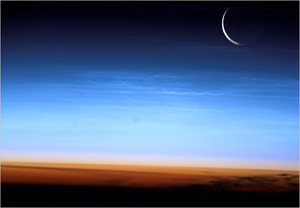Two hundred seventy thousand feet above the ground, higher than 99.9 percent of the earth's air, clouds still float around - thin, iridescent wisps of electric blue.
NASA is launching a small satellite to take a closer look at these clouds at the edge of outer space and to try to understand why, in recent years, they are appearing more often over more parts of the world. They are also becoming brighter.

|
| ©Ed Lu/NASA
|
| Noctilucent clouds are more easily seen from space as this photograph from the International Space Station shows. Since 1980, satellite observations show the number of noctilucent clouds increasing about 28 percent per decade. The ice crystals in the clouds also appear to be getting bigger, with the brightness of the clouds rising about 7 percent per decade.
|
The clouds are called noctilucent or "night shining," because from the ground they can be seen only at night as they float about 50 miles above the surface, illuminated by light from a Sun that has already set below the horizon. (That is essentially the same effect that makes moonlight.)
The clouds form in the polar regions from mid-May to mid-August in the Northern Hemisphere, mid-November to mid-February in the Southern Hemisphere.
"They're beautiful," said James M. Russell III, co-director of the Center for Atmospheric Sciences at Hampton University in Virginia and principal investigator of the NASA mission. "The pictures do a good job, but it's not like seeing them."
A British sky watcher named Thomas William Backhouse was perhaps the first to notice the odd blue wisps in 1885, and many scientists thought that the phenomenon was an atmospheric effect caused by ash thrown up by the gigantic volcanic eruption of Krakatoa in Indonesia two years earlier.
Although the ash settled out of the air, the noctilucent clouds persisted and spread.
At first they were seen only at higher latitudes in places like Norway, Russia and England. Now they can be seen as far south as Colorado, at about 40 degrees latitude.
The essential ingredients are temperatures from minus 225 to minus 190 degrees Fahrenheit, water vapor and particles of dust that serve as seeds for the ice crystals that form the clouds.
Since 1980, when regular space-based observations of noctilucent clouds began, their number has increased about 28 percent per decade, and they are reflecting more light, because the ice crystals are bigger.
"The most plausible and leading theory is CO2 buildup, which causes global warming," Dr. Russell said. Increasing temperatures near the surface actually cause the upper part of the atmosphere to cool, and cooler temperatures could spur the formation of more clouds. "If that's true and we are changing the atmosphere in a remote location like this, that means we're changing the entire atmosphere," he said.
The satellite, called Aeronomy of Ice in the Mesosphere, or AIM, is 55 inches high by 43 inches wide and weighs 430 pounds. As early as tomorrow, a modified jetliner will take off from Vandenberg Air Force Base, Calif., with a rocket plane holding the satellite attached on its underside. At 40,000 feet, the rocket plane will drop away and, after igniting its engine, shoot upward.
When the AIM reaches its orbit 370 miles above the Earth, its three instruments will photograph noctilucent clouds, measure the size of the ice crystals and note conditions like temperature, air pressure and moisture levels. The $140 million mission is the first dedicated to studying noctilucent clouds.
Among the questions scientists hope to answer are these: Where is the dust seeding the clouds coming from? Is it composed of tiny meteors from outer space, particles wafting up from the lower atmosphere, or possibly charged atoms created in that part in the atmosphere?
Another mystery: noctilucent clouds in the Southern Hemisphere are about half a mile higher than in the north.
Reader Comments
to our Newsletter